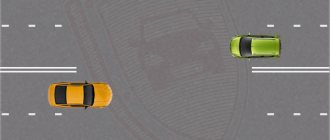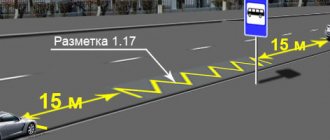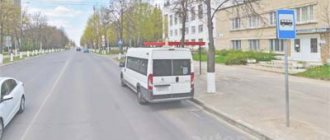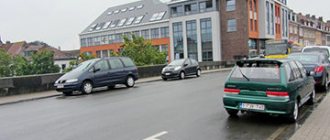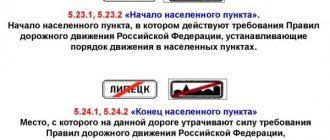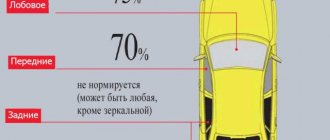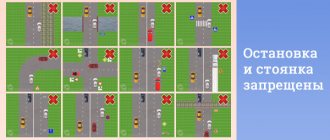What is a roundabout?
Circular traffic occurs on sections of roads that are shaped like a ring. Cars drive along it counterclockwise, this rule is typical for most countries where right-hand drive is common. Traffic lights are rarely installed at such intersections; traffic laws on them are regulated mainly by markings and standard signs
Brief description of small roundabouts
The radius of the arc roadway on the outer side should not exceed fifteen meters. The guide island, located in the middle, usually has a radius of about ten meters. The stripes themselves should be approximately five and a half meters wide in total.
At such road intersections, it is possible to organize an additional lane to relieve traffic.
Such rings are usually located on roads in order to reduce traffic in residential areas. As a rule, on such sections of the road the speed of cars is no more than thirty kilometers per hour.
There are also ordinary nodes with an island with a diameter of four to ten meters. They are located in conditions of limited space. The center is marked with markings or slightly raised to allow large vehicles to pass through it.
Also, do not forget about the existence of areas for transport with roundabout traffic. They defy the usual rules of classification. Here you need to proceed from different data about this section of the road. They are not subject to the normal rules of arc movement.
What signs are installed?
The main sign (4.3), indicating the entry into a roundabout zone, is presented in the form of a circle.
The blue background has three white (semicircular) arrows along the edges. Other signs may also be installed:
- 2.4 “Give way” - indicates that the driver should give way to vehicles moving in a circle;
- 2.5 “Driving without stopping is prohibited” - when approaching the intersection area, a road user must stop, make sure that he can continue moving without violating the rules, and only then cross the border of the intersection.
In some cases, a “Main Road” sign is placed. It sets the priority for the movement of cars.
The participant driving on the main road must be let through by drivers driving on the secondary road.
Driving around a roundabout
According to the traffic rules, the roundabout of the intersection must be overcome in accordance with certain requirements. The circle at such an intersection is the main road , and all the others are secondary.
When negotiating an intersection, the driver must follow the traffic lane. Losing your lane can cause discomfort to other road users and even create an emergency situation on the road.
Right turn at a roundabout
Performing such a maneuver obliges the driver to slow down, turn on the turn signal and move into the far right lane. When entering a roundabout, you need to make sure that other vehicles allow the new vehicle to pass. This approach ensures that a new traffic participant at the intersection will not interfere with motorists entering the roundabout.
Left turn at a roundabout
The rules for driving through roundabouts oblige the driver in this case to first change lanes into the appropriate lane. If there are several lanes, the driver must take the leftmost lane. In the case of two-lane traffic, you must begin the maneuver in the left lane, and after overcoming the first or second exit, you must take the right lane. It is very important here to remember to turn on the appropriate turn signal.
Negotiating a three-lane roundabout is done in the same way. Only here the driver must change lanes to the right twice. This maneuver should be performed very carefully, objectively assessing the current situation on the road. The named methods of overcoming a roundabout are relevant only when a different traffic order is not determined. To decide who is in charge, you will have to pay attention to the signs and road markings used.
Go straight
Roundabouts can have varying numbers of adjacent roads. This feature will determine the driver’s further actions when performing a maneuver. If the number of bands exceeds 2, then you should choose the middle one. If there are two rows, the optimal choice is made based on the situation on the road at the time of the maneuver. If the car is moving on the main road, then before entering the intersection you should make sure that other cars allow the vehicle to pass. Driving on a road of secondary importance obliges the driver to let everyone through.
Driving through a roundabout and continuing straight can also be done in the right lane. However, this can significantly complicate the traffic situation if the driver from the middle row wants to maneuver to the right. To avoid such situations, it is best to occupy one of the central rows. Before entering an intersection, the driver must give way to pedestrians.
How to choose a band?
Unlike regular intersections, the driver has the right to enter the roundabout from any lane. But at the same time, he is obliged to occupy a lane in the circle corresponding to the one in which he was before entering:
- if from the far right lane, then after entering you must be on the far right;
- if from the far left, then you should go to the far left.
No changes to other lanes are allowed and are a serious violation that can lead to an accident on the road.
If the number of lanes in the circle area does not correspond to the number of lanes before it, then the driver must move the car into the appropriate lane in advance.
After entering a roundabout intersection, you are allowed to change lanes into the desired lane. In this case, it is necessary to use a warning signal about the maneuver: using standard means (turn signals) or hand gestures (when moving, for example, on a motorcycle).
How to choose a lane when passing an intersection?
When entering a roundabout, it is of great importance which lane the road user entered the intersection from. In accordance with clause 8.5 of the traffic rules, entry to the roundabout is possible from any lane of the adjacent road .
Provided that, after crossing a roundabout, a road user needs to turn right or go straight, then it is most advisable to occupy the right lane. Accordingly, if you need to turn left, you should choose the left lane. Such actions will also be relevant for drivers who want to make a U-turn in the opposite direction. You should occupy the central lane only when further movement is straightforward.
Travel details
The ring area is almost always a main road, so drivers traveling along it have higher priority than incoming cars.
Right turn
A right turn should be made in the following sequence:
- Make sure that the maneuver will not disturb other motorists.
- Reduce speed.
- Turn on the right turn signal or warn other drivers about your actions using a gesture: left arm bent at the elbow.
- Carry out a rebuild.
Go straight
If there are three or more lanes in a roundabout area, it is recommended to move along one of the middle ones.
In other cases (if there are only 2 lanes on the road), the choice of lane should be chosen based on the plan for further actions. It is important not to interfere with other motorists. Including those who plan to enter the intersection area.
Left turn
If there is a two-lane road, the maneuver is carried out from the left lane. Be sure to use warning signals.
If there are three lanes, then you should be especially careful when changing lanes.
Non-standard situations
Driving through roundabouts can cause certain difficulties if special markings are applied to the roadway or additional road signs are installed.
If there are markings like 1.16.1 - 1.16.3 or decorative elements (elevations, flower beds), the driver will not be able to drive along the entire diameter of the circle in the rightmost lane (which is usually recommended). Therefore, in this situation, you should take the second lane from the right edge.
Sometimes additional signs (or special markings) indicate the directions in which the driver has the right to travel:
- signs 5.15.1, 5.15.2;
- marking 1.18.
You should definitely follow them.
Driving through a roundabout intersection
When performing a maneuver, the motorist must pay attention to all the signs that stand in front of and on the roundabout. In normal situations, priority goes to those moving in a circle, but this does not always work. If a driver does not comply with traffic rules and breaks the lane while driving, then he can not only interfere with others, but also create an emergency situation.
Below are provisions that should be observed in certain situations:
- When turning left, you need to change lanes. On a multi-lane roadway, you should take the far left lane. You also need to turn on your turn signal and reduce your speed.
- When turning right, the speed also decreases and the turn signals turn on. But now we need to occupy the far right row.
- If there are only two lanes on the roadway, the maneuver should begin in the left lane. But, when the first two exits have been overcome, you need to change into the right lane. At intersections with three lanes, the same rules apply. Note: if signs on the road indicate a different process of overcoming, it is worth following it.
- If you are driving straight and there are more than two lanes at the intersection, you should choose the middle one. This way, when leaving this lane, you will not interfere with others who want to turn. When there are only two lanes on the ring, you need to continue driving based on your assessment of the situation on the highway.
- If a driver enters an intersection from the main road, he needs to be sure that all vehicles are ready to let him through.
However, you can stay in the lane on the right, but in case someone wants to swerve, it will create some interference. It is also worth remembering that when entering a roundabout, you must first let all pedestrians through. When exiting, this driver needs to let everyone in front pass.
Exiting a roundabout
You should leave the roundabout only from the far right lane. When driving on 2 or 3 and other lanes, the following sequence of actions is recommended:
- Make sure in advance that the subsequent maneuver will not interfere with other drivers.
- Turn on the right turn signal or make a gesture to inform other drivers about the intended maneuver.
- Reducing your speed slightly, change lanes.
- If necessary, repeat steps 1-3.
- Having taken the far right lane, exit the intersection.
It is important to monitor the presence of uncontrolled pedestrian crossings and allow people to pass if necessary.
Leaving an intersection not from the extreme right position
Let me remind you that before leaving a roundabout, you must take not only the far right lane, but also the far right position in this lane.
Violation of this rule is punishable in accordance with Article 12.14 of the Administrative Code:
Article 12.14. Violation of maneuvering rules
11. Failure to comply with the requirement of the Traffic Rules, except for established cases, before turning right, left or making a U-turn, to take in advance the appropriate extreme position on the roadway intended for traffic in a given direction -
entails a warning or the imposition of an administrative fine in the amount of five hundred rubles.
Fine for wrong way
Traffic regulations establish the following sanctions for violation of the rules:
- Driving (exiting or entering) on a red traffic light - the primary punishment is a fine of 1 thousand rubles, for a repeated violation - 5 thousand, and can also deprive the right to drive a vehicle for up to 6 months.
- If a motorist does not allow a car that has higher priority on the road to pass , a fine of 1 thousand rubles will be issued.
- If you ignore the rule about the need to warn other road users about the upcoming maneuver (changing lanes, turning), the driver will be punished with a fine of 500 rubles.
- Driving in the oncoming lane is a serious violation; the violator may be deprived of his driving license for a long period. Traffic police officers also have the right to impose fines.
- Violation of parking rules - if the car is left closer than 5 meters from the intersection of roads, the violator can get off with a warning or a fine (500 rubles).
Fine for not turning on a turn signal
A turn signal at a roundabout must be given before entering an intersection, before leaving an intersection, and before changing lanes at an intersection.
The fine is provided for in Article 12.14 of the Code of Administrative Offenses:
Article 12.14. Violation of maneuvering rules
1. Failure to comply with the requirement of the Traffic Rules to give a signal before starting to move, changing lanes, turning, turning around or stopping -
entails a warning or the imposition of an administrative fine in the amount of five hundred rubles.
Specific examples with comments
Example 1 . In this example, the driver of the red car should give way (point 1).
In this case, the intersection is considered equal, and the white car is approaching from the right side of the red car. That is, the “Interference on the right” rule applies.
At point N2 the situation is different: both vehicles are in a roundabout area, but the white vehicle leaves the circle and interferes with the red car, so it is the driver of the white vehicle who will have to let the second motorist pass.
Example 2 . The driver of a blue car violates the rules by leaving the intersection from the left lane.
In this situation, everything looks harmless: both cars are moving in parallel and performing a similar maneuver, so a collision will not occur.
But there may be another option.
The driver of the red car decided to continue driving around the ring, so the blue one is obliged to let him through in any case, because he is moving in a straight direction and does not change lanes. The situation is dangerous; if the offender (the owner of the blue vehicle) decides not to let the second car pass, then the likelihood of a collision is extremely high.
Leaving the roundabout lane
Having figured out how to properly enter a roundabout intersection, you need to decide how to exit this section of the road. The traffic rules clearly state that exiting an intersection must be done exclusively from the right lane. Before changing to the next lane, the driver must objectively assess the situation on the road and let all cars moving on the right pass.
Important! Entry to a roundabout intersection is permitted from any lane, and exit is only from the right .
One of the main features of negotiating roundabouts is that overtaking is allowed on this section. Stopping is allowed 5 meters from the junction of the intersection and the road.
Video: Priority when driving through roundabouts
What signs are installed before a roundabout?
The section of the road containing traffic around the ring is equipped with a road sign numbered 4.3. and a “give way” sign. Since 2010, the second of these signs instructs drivers who have not yet entered the circle to give way to those who are moving along it or leaving it.
According to the traffic rules, the absence of a “give way” sign is not a basis for eliminating the priority of movement for vehicles located on the circle.

